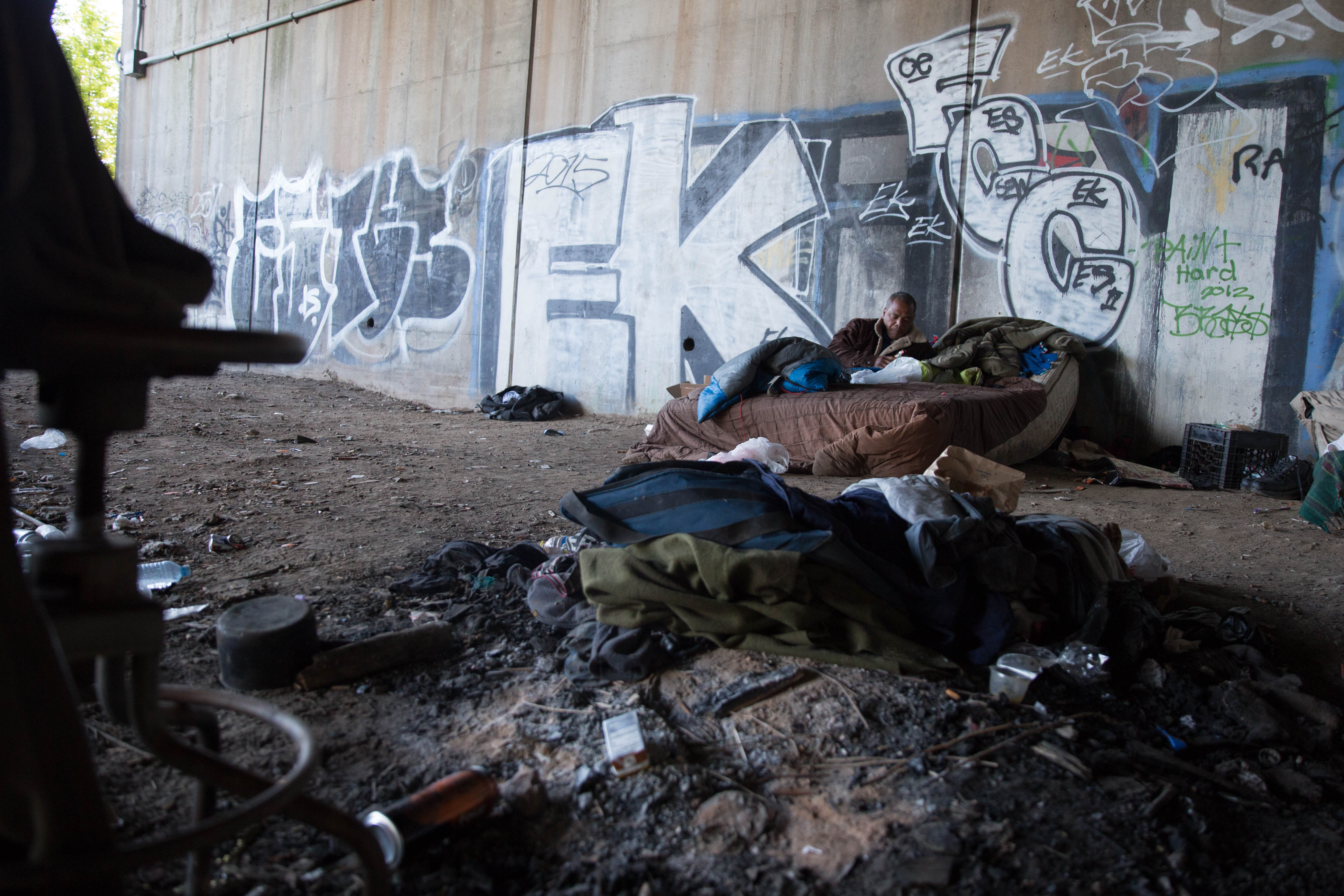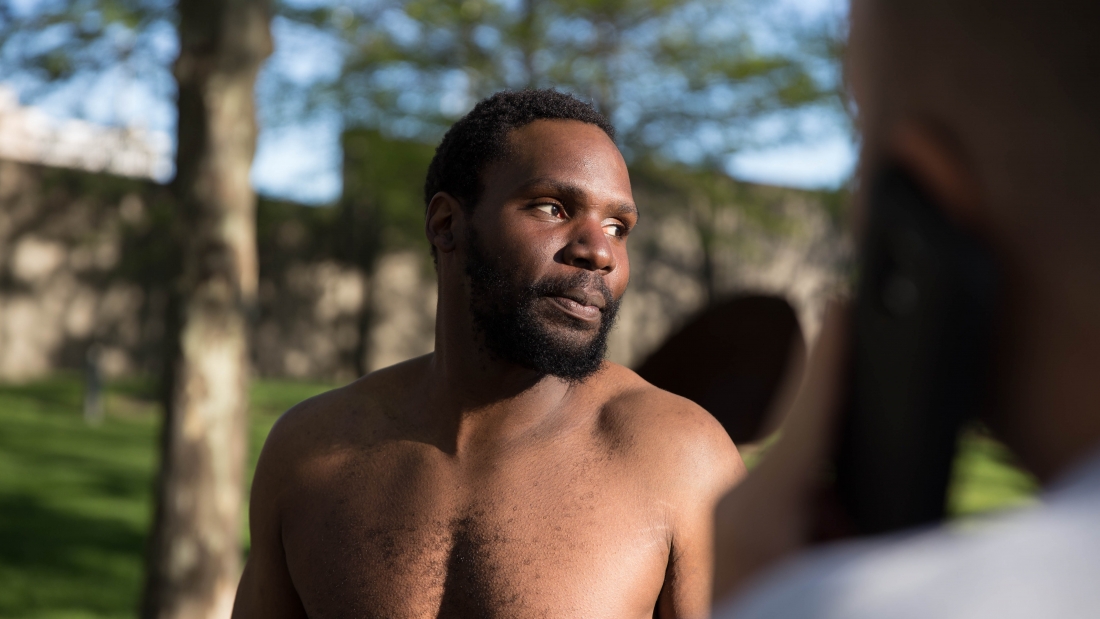We Must Not Go Back to the Bad, Old Days of Homelessness

Paul, a homeless veteran, sits on a mattress under a highway bridge in Hartford on May 11, 2017. Photo by Ryan Caron King for NENC
OPINION
Just 45 minutes into the weekly rounds of Dave DuVerger — a homeless outreach worker at South Park Inn’s in Hartford, Connecticut — he handed out his last lunch.
DuVerger’s clients that morning included three people in a park, two in a tent by a highway, and eight more huddled on filthy mattresses underneath some bridges. It is unusual to find so many people — 15 and then some — sleeping rough in the capital city. DuVerger made a note to pack more lunches the next week.
Get ready for the future: activists and advocates say there’s a storm coming of increase in states’ homeless populations.
The current political climate, and state and local budgetary rolls, are threatening to roll back the clock on a time of unprecedented success in housing the most vulnerable among us. In 2015, the federal government confirmed that Connecticut had ended chronic homelessness among veterans. The next year, Connecticut became one of the first two states to end all veteran homelessness.
But anti-homeless programs cost money to set up and implement, and that is not a popular message these days.
In March, President Donald Trump proposed cutting $6 billion – with a b – from the Department of Housing and Urban Development, which has been instrumental in the success states like Connecticut have seen in eliminating homelessness.
Trump also proposed an end to community development block grants, a vital part of the equation for programs such as Connecticut’s Journey Home’s aerospace employment placement program. The anti-homeless organization partnered with Belcan Corporation to provide on-site training that ends in a full-time job – with benefits – for people who are homeless or have experienced homelessness.
Those same kinds of grants allowed Maine advocates to focus on housing rehabilitation and job training.
Already, activists and advocates are feeling the pinch. In December, Massachusetts Governor Charlie Baker announced some $98 million in cuts to a variety of programs, including homelessness and housing, and substance abuse treatment programs. But last month, Baker announced about $20 million for affordable housing projects around the state.
Meanwhile, a report from the Boston Foundation earlier this year said that the number of homeless families in the state had doubled in the last nine years – one of the largest increases in the country.
Vermont’s House of Representatives voted to scale back the state’s practice of paying for motel rooms for its states homeless residents on the coldest nights of the year. And then House representatives voted to expand the state’s temporary shelter policy for pregnant women and families with children.
Last month, Hartford Mayor Luke Bronin held a public hearing to explain his proposed $8.8 million in cuts, including $866,326 in cuts to programs such as Journey Home, which has been instrumental in ending homelessness in Connecticut. Under the proposed budget, Journey Home would lose all of its city funding: $85,000. For his part, Bronin has been talking about taking a more regional approach to social ills like homelessness, and efforts are underway to find alternative funding. The city is supposed to adopt the budget by the end of this month.

Marilyn Rossetti of Open Hearth. Photo by Ryan Caron King for WNPR
“Cuts always affect us,” said Marilyn Rossetti, long-time executive director of Open Hearth, a shelter that opened in 1884 in Hartford as a reading room for men to come in from the streets. “Do we lay off staff? Do we offer less in the way of services for the men? Do we cut benefits to the employees? And the list goes on.”
Meanwhile, in April, Ben Carson, who’s Secretary of Housing and Urban Development, toured housing projects in Columbus, Ohio, and fretted that residents there were getting too comfortable.
Early in his recent outreach, DuVerger found a young man he knows sleeping in a park. The young man had a bed in a shelter, but the place was haunted, he told DuVerger, and he couldn’t stay there.
DuVerger handed over a lunch, and encouraged the young man to call his case manager, who was looking for him. That young man, DuVerger said later, has cycled in and out of shelters. He’s been in a jail. He needs to be in a hospital. If we keep ignoring him, the public funds we’ll spend will add up into the hundreds of thousands. So we pay now. Or we pay much, much more later.
Ironically, the most recent news about homelessness in Connecticut is good. The state’s latest Point-in-Time count, the annual homeless survey required by the federal government, shows a third drop in homelessness in four years –– and the lowest number ever, since the census began in 2007. The census, taken January 26, counted 3,387 people experiencing homelessness. That figure is down 13 percent compared to 2016, and 24 percent compared to 2007.
In addition, chronic homelessness in the state is down 60 percent since 2014. The number of people who were sleeping rough — such as clients of South Park Inn’s homeless outreach team — was down 38 percent, to 415. In addition, just 34 veterans were found in shelters, down 24 percent from last year. Just 14 veterans were found sleeping rough, down 67 percent from last year.

Dave Duverger walks into a rail tunnel in Hartford on May 11, 2017. An empty sleeping bag sits by the tracks. Photo by Ryan Caron King for NENC
Those numbers are the result of an unprecedented effort on the part of public and private agencies who’ve moved heaven and earth to get people housed with whatever supports they needed. All that costs money. Case managers cost money. Supportive services cost money, as well – but it’s still cheaper than the bad old days of ignoring the problem.
If only we talked about the long-term effects of those cuts. According to a 2014 report out of Florida, providing permanent supportive housing for people who are chronically homeless with disabling conditions costs about $10,000 a year.
Meanwhile, doing what we’ve always done with people who are chronically homeless — ignoring them as they cycle in and out of shelters, jails, and hospitals — can cost three times as much.
So we can talk about short-term savings, and impoverished families getting too comfortable in public housing, but surely this is an idea everyone can get behind: It just makes fiscal sense to provide housing and services to the people who need them. We can’t afford to go back to the bad old days.


